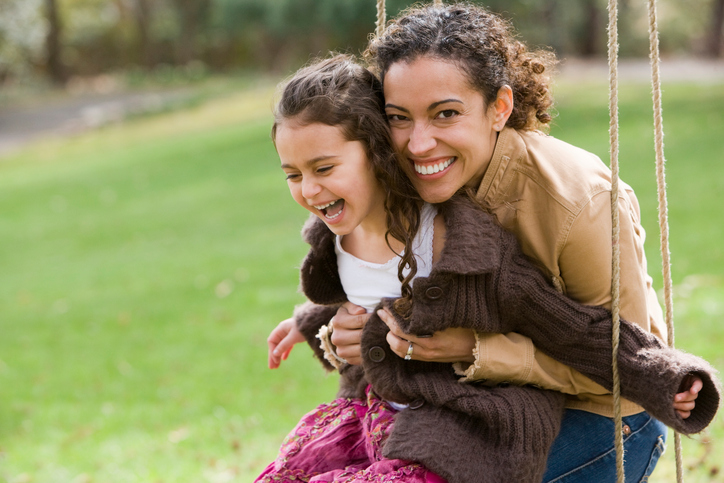
Avery: “No Mommy, I’m sitting on the swing.”
Mommy: [verbally empathize with her and acknowledge how she must be feeling] “Avery is having so much fun on the swing. You must want to stay and swing for a long time. [Setting the limit] But we need to fill our hungry bellies with a yummy lunch so we need to go home. Let’s race to the stroller!”
Avery: “No Mommy, I sit here on the swing.”
Now, we all know this can go on and on and on. The two and a half year old will get hungrier, and the mom will get more frustrated. So far, Mom has done an amazing job of empathizing. She stated a limit. The child did not cooperate happily with the limit. Since Mom is clear that her limit is non-negotiable, it's time to show that to her daughter.
Mommy: “Avery, you want to stay in the swing, all day, don't you?" [Wish fulfillment]
Avery: YES!
Mommy: "I wish you could. But now it's lunchtime and we have to go home. You have a choice, you can jump down and walk with me, or I will pick you up and you can ride in the stroller." [Mom gives a choice, either of which is palatable to her. This helps Avery save face and gives her some control.]
If Avery doesn’t select one of these choices:
Mommy: “Ok, Sweetie, I see it's too hard for you to leave the swing yourself. I will help you down and into the stroller."
Let's assume Avery howls as Mom picks her up. Most parenting advice says to wrestle her into the stroller and ignore her crying, so we don't "reward" her crying with attention. But that breaks our connection with our child and is disrespectful (would you do it to your spouse?) What's worse, we give her the message that her emotions are bad, and we will only attend to her if we like what she is expressing -- in other words, that our love is conditional. She's all alone with those big scary feelings.
So should we try to distract our child from her upset? “Wow, Avery, look at that cute doggie right there!” Nope. That's dishonoring her experience, and telling her that her emotions are too scary for us to deal with.
Instead, we use Empathic Limits. That means we go ahead and insist on a limit that is non-negotiable to us -- after all, the two year old should not be making all the decisions for the family. But we offer empathy for our child's upset in response to our limit.
Avery: [Begins to howl as we pick her up from the swing.]
Mommy:
"You are crying. You don't want to leave the swing. You are so sad and mad that we have to leave. I'm sorry you can't swing all day, but it is lunchtime. I will sit with you on this bench and hold you while you cry."
Despite the fact that the other parents at the playground are staring at us, we are not failures because our daughter is crying. In fact, crying is good, and helpful, for a two year old with big feelings. She needs to express them and show them to us, not to "stuff them."
As she cries, if we can hold her and help her to feel safe (instead of strapping her into the stroller and pushing her home, sobbing), she may even begin to cry about other things -- her new baby brother, or the way Daddy snapped at her when he was in a rush, or that big dog that barked at her this morning, or how much her knee hurt when she fell yesterday but she didn't cry because she was with Grandma who told her what a brave big girl she was and big girls don't cry. What a great opportunity to get all this off her chest! In fact, often kids "pick fights" by resisting our limits, exactly as Avery did with the swing, precisely to get the opportunity to cry like this. So holding our child while she cries is a tremendous gift.
As she cries, we stay connected by holding her. We keep the tears coming -- yes, on purpose! -- by empathizing and reassuring her that she is safe:
"You are sad, you are crying, I am right here, you are safe, you can cry."
If she is angry and twists away, we stay nearby and stay connected with our voice: "I'm right here. I won't leave you alone with those big feelings." We breathe deeply to stay calm. We ignore the curious looks from passersby.
Finally, she begins to calm. She is snuggled in our arms. We give her a big hug. "You were crying. You were sad. Now you feel better. Let's go home and get those yummy sandwiches. Do you want a drink of water before you get in the stroller?"
After a good cry in your loving presence, your child will be free of whatever feelings were making her stick to her position at the expense of getting along with you. She will feel relaxed and cooperative. (When kids are rigid and insist on getting their way, that's a red flag that they need to cry. Just like with adults. But that's another post.)
The first time you do this, your child may cry for a long time. That is never a bad thing; she's venting pent-up emotion. Or she may think that her crying will convince you to let her swing more. Obviously, empathizing with her feelings doesn't mean you rescind a limit that is important to you.
But before long, your child will climb reluctantly from the swing and into her stroller when you say it's time for lunch. She will have learned from experience that your limits are firm, even if she can't understand why they're important. Because of your empathy, she will also have learned that you really do care about her happiness, that feelings are manageable, that disappointment can be weathered. That's the beginning of resilience and emotional intelligence.
Finally, you will find that she is more accepting of your limits. That's because kids who test limits repeatedly are usually showing us they don't feel safe. Children may love the idea of being all-powerful, but it also terrifies them. They need to know that we as parents will be in charge and keep them safe. Once they're convinced of that, they no longer need to constantly test the limits to find out where our boundaries are.





